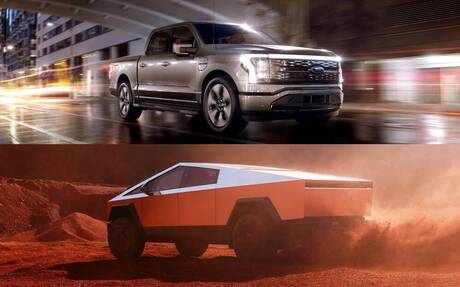Ford F-150 Lightning vs. Tesla Cybertruck: The Numbers
The Ford F-150 Lightning was the first full-size electric pickup to hit the Canadian market, but competition is about to heat up with models like the Rivian R1T, Chevrolet Silverado EV, GMC Sierra EV, Ram 1500 REV and of course the Tesla Cybertruck ready to take over.
We still don’t know exactly when the latter will arrive in Canada (aside from the prototypes that have been caught testing north of the border in recent weeks), but now that the production specs are out, let’s compare the Cybertruck with Ford’s truck.
- Also: Watch: Tesla Cybertruck vs. GMC Hummer EV, Which One’s the Fastest?
- Also: Tesla Cybertruck Adds “Toolbox-Sized” Battery as Range Extender
Dimensions
The Tesla Cybertruck stands 5,683 mm long, 2,413 mm wide and 1,791 mm tall, giving it a lower centre of mass. Speaking of which, it weighs 2,995 kg or 3,104 kg depending on the configuration. The cargo bed is 6 feet long.

The Ford F-150 Lightning, meanwhile, is 5,911 mm long, 2,031 mm wide and 1,989 mm tall. Generally lighter, it tips the scales at 2,731-3,130 kg. On the other hand, the cargo bed is a tad shorter at 5.5 feet.
Power
The Cybertruck offers tri-motor (“Cyberbeast”) and dual-motor AWD variants. With 845 hp and 600 hp, respectively, they accelerate from 0-100 km/h in just 2.7 seconds or 4.1 seconds. A single-motor RWD variant is planned for late 2025, but the numbers aren’t released yet.

The slower and less powerful F-150 Lightning can be had with either 580 hp or 452 hp, which results in 0-100 km/h times of 4.5 seconds and 5.1 seconds, respectively. We’ll see if Ford can cook up more potent versions in the next couple of years.
Towing and Payload
All Cybertruck models can tow up to 4,990 kg (11,000 lbs) and haul up to 1,134 kg (2,500 lbs) in their cargo bed, far better figures than what the F-150 Lightning is posting.

Ford’s electric pickup has a maximum towing capacity of just 3,493 kg (7,700 lbs) with the smaller battery and 4,536 kg (10,000 lbs) with the larger battery. In Platinum trim, however, the number is down to 3,856 kg (8,500 lbs).
Payload ranges from 885-1,014 kg (1,952-2,235 lbs) depending on the battery, with the higher rating achieved with the smaller pack.

Storage
Both trucks feature a front trunk or “frunk” under the hood. Tesla has not yet specified how capacious the Cybertruck’s is, but based on the pictures we’ve seen online, it’s significantly tighter than that of Ford.
Thanks to a boxier, more imposing nose, the F-150 Lightning is able to offer a 400-litre frunk with a payload of 400 lbs, not to mention an underfloor and drain plug.

Battery and Charging
The Tesla Cybertruck uses a 123kWh battery that provides a range of 515 km in tri-motor configuration and 547 km in the dual-motor variant. But wait: a second, optional battery—occupying about one third of the bed area—increases range to more than 705 km and 755 km, respectively. That’s according to Tesla, but any way you look at them, the numbers far eclipse those of the F-150 Lightning.
As for charging, with its 800V architecture, the Cybertruck has a maximum charge rate of 250 kW and is able to regain 235 km of range in only 15 minutes when plugged into a Tesla Supercharger, the company says.

The F-150 Lightning offers a choice of two batteries—98 kWh or 131 kWh. The former enables only 386 km of zero-emission driving, while the latter makes it possible to travel up to 483 km or 515 km depending on the model. Whether you’re talking about Tesla or Ford, these range estimates are achieved in ideal conditions, without a trailer in the rear.
Charging is not as fast since the F-150 Lightning has a max charge rate of 150 kW (according to Ford). In the best-case scenario, 10 minutes at a DC charger that can deliver that much power will give you 66 km of range with the smaller battery and 87 km of range with the bigger one.
Prices
For now, pricing for the Tesla Cybertruck in Canada remains a mystery. In the U.S., it starts at $60,990 and goes up to $99,990—even $120,000 for the limited “Foundation Series” launch models. The price tags will inevitably be higher on this side of the border, and no EV rebates will apply.

The F-150 Lightning ($54,995-$91,995 in the U.S.) is more affordable in both markets. Canadian pricing ranges from $59,000 for the base Pro model (now available to both fleet and retail customers, with EV rebates of up to $12,000 depending on your province) to $115,000 for a top-line Limited model.
Warranty
The last item we want to point out is the warranty. The Cybertruck is covered for 4 years or 80,000 km, while the battery is covered for 8 years or 240,000 km.
Ford is not as generous as Tesla, offering 3 years/60,000 km vehicle and 8 years/160,000 km battery coverage.
